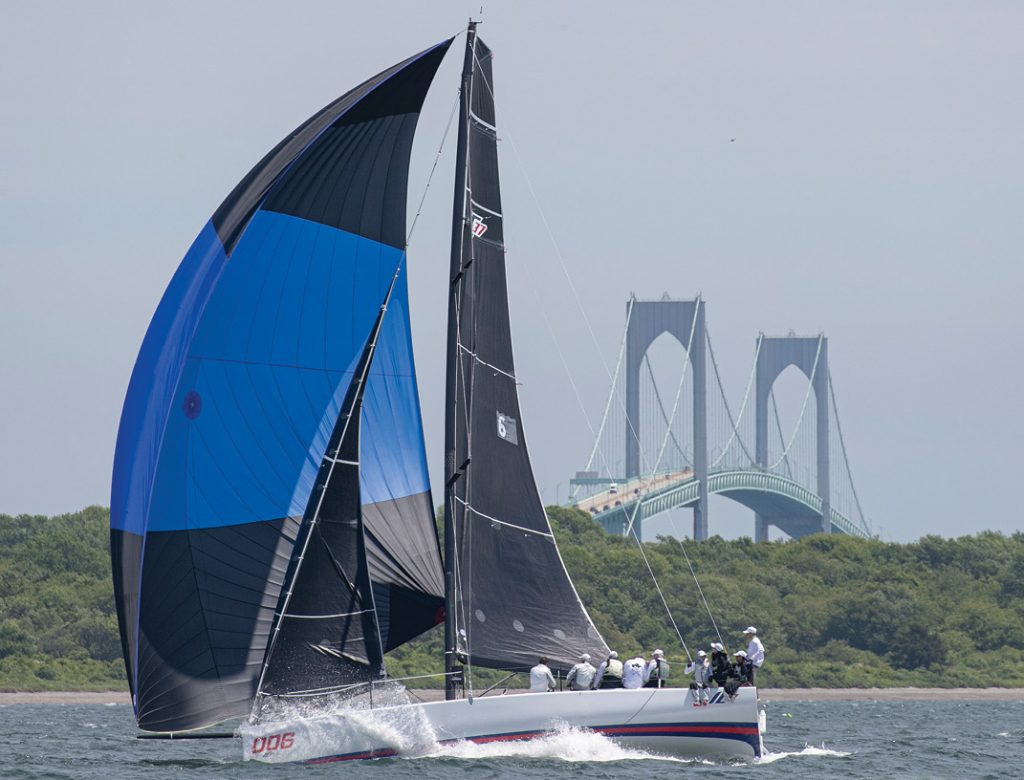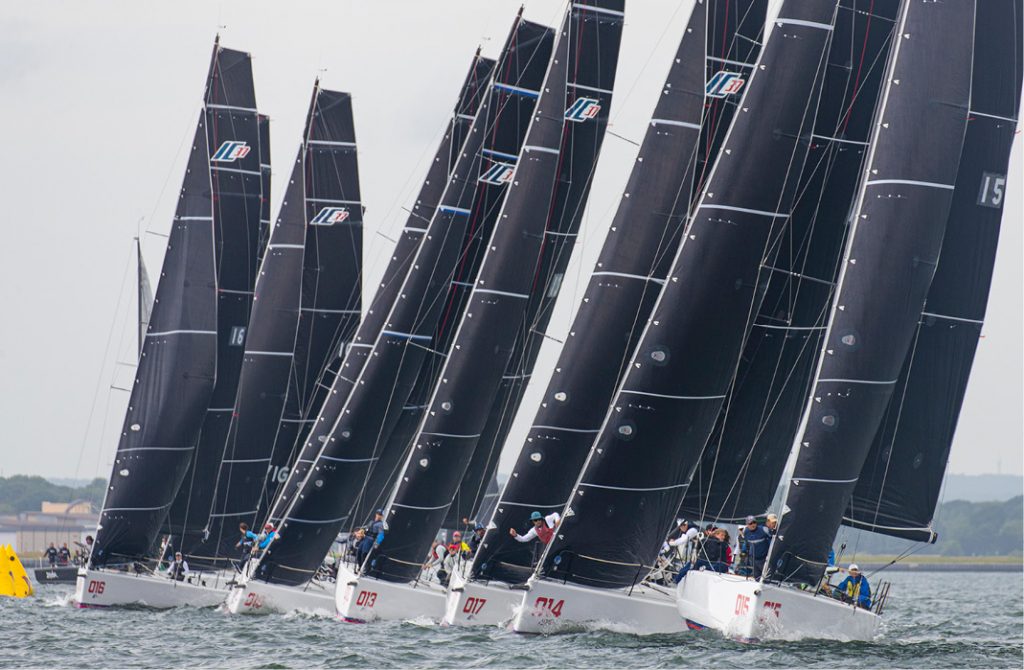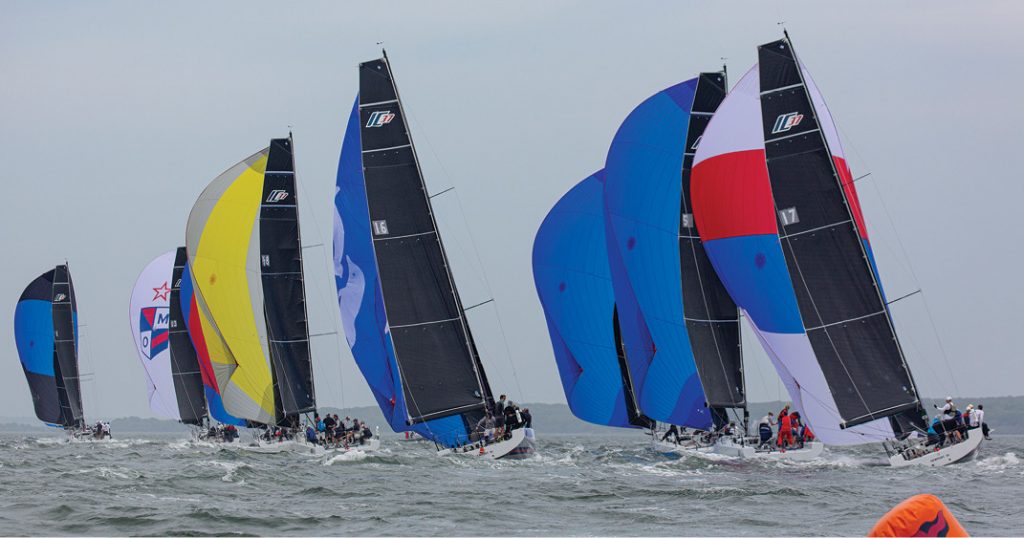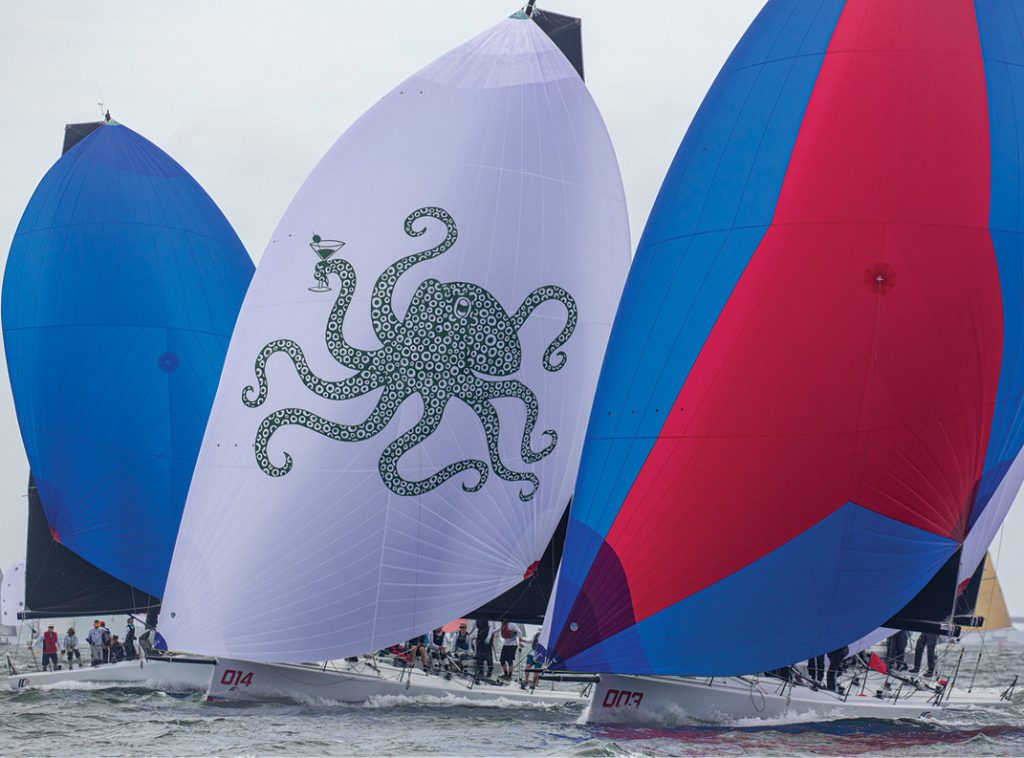By Ben Cesare

Planing down the west side of Conanicut Island, the Melges IC37 gets up and goes very readily in 15 knots true. © Stuart Steuli
On June 1 and 2, twenty brand-new Melges IC37s, 131 amateur sailors, a team of coaches from North Sails, the team from Melges Performance Sailboats, and the team from New York Yacht Club who were responsible for getting the boats in the water and ready to sail, gathered at Sail Newport in Newport, RI for an inaugural “training weekend.” Class President Phil Lotz welcomed all, thanked all who had made it possible and then turned it over to Ken Read, President of North Sails, to begin the seminar. The most interesting words from Kenny were, “Everybody is going to have to be really observant, watch for issues with the boats and please, sometimes you may have to be patient because…well, because this has never been done before!” Ken had every reason to set expectations. Designer Mark Mills had been signed in May of 2017, hull #1 was christened in May of 2018 and twenty boats were about to go sailing, the last three being commissioned just days prior.
Since then, there have been thirty-one races over four regattas, culminating in the New York Yacht Club 175th Anniversary Regatta in July, in which twenty-one boats competed. This month, the club is hosting the Rolex New York Yacht Club Invitational Cup (the biennial regatta for which the IC37 was conceived) and the inaugural IC37 U.S. National Championship, where it’s expected that as many as 24 boats will compete. Per the class rules, every boat will have only one World Sailing Group 3 professional as a “boat captain” who will not be allowed to call tactics, trim sails, nor play the running backstays. Additionally, out of a crew of six to eight weighing a max of 1,512 pounds, two will be of the opposite gender. And if the youth section of the class rules is in effect, a sailor of 16 years or younger will race without counting against a crew’s numbers or weight.
This early success bodes very well. For sure, there are some challenges on the horizon and probably some below, but if this trajectory continues there’s going to be a lot of really fun one-design sailing that might introduce a whole generation of young sailors to the sport of “big boat” racing. “Hold on,” you say. “You’re not going to drum up that incredibly tired ‘losing kids to other sports’ diatribe again.” No, not today. But many aspects of the IC37 Class are going to have a real impact on the sport. Let’s start from the beginning.

A generous line is helpful, but these starts will definitely be testing the teams. © Stuart Steuli
Three years ago, the inter-yacht club regatta hosted by the NYYC known as the Invitational Cup was facing a fork in the road. It had been very successfully held three times as a “Corinthian” regatta (owner/driver and only one Category 3 sailor per team allowed) where teams from yacht clubs around the world gathered in Newport to race Swan 42s. Those boats were privately owned or chartered from private owners, and as a boat that filled many roles (one-design, offshore, rating rule and cruise-ability) the Swan 42 did quite well, serving that event for five iterations from 2009 to 2017. But it was definitely a large investment with all of the expense of running a 42-foot racer-cruiser, including extensive sail inventories for both one-design and other racing. Eventually, many of the fleet left the Northeast and by 2017 the club needed to find a new boat to continue the event.
Standing at this fork in the road was Phil Lotz, then Commodore of the NYYC and Paul Zabetakis, then Chairman of the NYYC Sailing Committee. Zabetakis is a very experienced offshore one-design campaigner who has owned a Frers 33, Mumm 36, a Farr 40 and a Swan 42, all named Impetuous. It was his job to execute on the vision that he and Lotz had. This vision was for a new, purpose-built boat for the Invitational Cup that would also endure as a class beyond the “IC” and very importantly, would limit costs to an extent that the class would grow without the “arms race” woes that hurt so many other one-design efforts. As you might imagine, when starting with a blank sheet, a lot of other ideas and desires started to add to the list of requirements.
Step one, Zabetakis and Co. built a set of formal Vision Statements (see below). The “Co.” was a committee he formed to be chaired by Art Santry and including more than twenty NYYC members, who brought all manner of yacht ownership, professional industry and amateur racing experience, age and gender diversity to the table. The Vision document was a critical start. In each of the subsequent meetings where a myriad of detail decisions came up, such as retractable sprit or fixed, coffee grinders or not, wind instruments or not, etc. etc, the team would refer back to the original Vision and make the decision. For these sessions, Zabetakis used a technique called “multi-voting,” often used in product management processes, which allows a group to reduce a large list of items to a few prioritized ones.

To “heat her up” and go a knot or more faster or to slide down low and away are key decisions in the 12-14 knot breeze range. © Stuart Steuli
Another equally critical step was getting somebody to help capture these decisions in an RFP (request for proposal) document that would crystalize the vision work into a single “actionable” list for a designer, builder, mast and sailmaker to deliver the desired kind of boat. Barry Carroll was asked to bring his extensive career’s worth of boat and class building knowledge to the party. The committee also immediately recognized the benefits of running the effort as a charter program. By committing to purchasing twenty boats at the outset, with a financially feasible plan to cover costs by chartering them, the typical problems of fleet building were largely solved. Normally, generating interest in an exciting new platform is not the problem. It’s getting the commitment by an owner to be one of the first ones in. Typically it’s, “Sure, I’ll buy one…I’ll buy boat #6.”
This process may not seem that unusual when executed by owners, yacht designers, sailmakers and builders when building a one off boat or even a “line” of boats. What is totally different in this effort is the nature of the vision. The class rules are so restrictive and the concept so pure, with the intent being that the first twenty boats are totally interchangeable and that they will be identical to boats #21 all the way to boat #100 and beyond. All of the details had to be “right” from boat #1. That challenge makes the outcome all the more impressive.
By now one would be forgiven for asking, “Sounds too good to be true…how much?” A new IC37 costs approximately $280,000. The one-design sail package, comprising a reefable main, reefable jib and two spinnakers, costs under $30,000. These numbers compare very favorably to similar size performance boats. And yes, early results show that the IC37 can be sailed under various rating rules very competitively. An individual, a syndicate of owners or a club can fairly easily afford to finance this boat, race it locally under a rating rule (hopefully packed with juniors), and then race it against twenty or more boats in amateur one-design competition.
So now that this class is launched, with seven private boats already delivered or ordered to join the initial twenty, what’s going to happen…why is this one going to be so impactful? For one, the boats are legitimately modern race boats while accomplishing the goals of the Vision for the body type able to sail them and for simplicity and affordability of running them due to the extremely tight class rules. They are not easy to sail well for a first-time crew, but they are easily mastered with some practice. Teams that have been very successful in other kinds of boats are rediscovering the age-old adage of “time in the boat” makes one fast. Those who have done most of the races so far are one hundred percent better than they were June 1. By the same token, the lack of a long list of details to prepare the boats to go racing lets a team focus more on going sailing. For example, with only four sails total, the chore of putting them away is minimal. The racing is very, very close and very rewarding. In one race, a boat I was on went from 4th to 8th to 15th and back to 6th again in one 60- minute race!
There are challenges with getting six to eight amateur sailors to commit to a full season, but that’s no different than any other program. Plus, as the pool of experienced crew grows, this will be much less of an issue. In fact, it will be an advantage to this fleet as experienced crews, as in other one-designs, become plentiful. Throw in the junior advantage in the class rule, and a healthy cadre of capable 14 to 16-year-olds should soon become race ready. Also, the performance of the boats is going to incent the “pre-pro” (pre World Sailing classification requirement due to age) or college racing set to want to race them. We sailed with a recent College of Charleston Offshore Team grad, and she was very comfortable, capable and excited to race these boats.
Beyond these outcomes, what was probably most noticeable this summer was the number of women above and beyond the class rule requirements that were sailing, as well as the number of legitimate family programs on the start line. Brute strength is not required and the platform’s shape and weight limits do not require Star crew-sized people to be on the rail. I’d guess half of the headsail trimming duties were handled by women as well as half of the bow jobs, while a number steered or called tactics. Another very noticeable aspect was the number of “reformed” professional sailors or otherwise highly accomplished sailors present throughout the fleet, often augmenting the family programs. I have not seen some of these sailors on “big boats” since, well, since Farr 40 days!
One last anecdote before I put down the pom poms. We had a 16-year-old, a slight 420 skipper, with us for a few days of the five-day 175th Regatta. He seemed a good sailor, fit and coordinated when moving around the boat but didn’t say much…very, very quiet. I was thinking, “He’s very polite and doesn’t appear to be shy… he seems a standard issue teen.” (forgot his gear on the chilly, rainy day and despite our offers…he was totally fine and didn’t care..like I said…standard.) I thought, “Maybe he’s not impressed with our sailing.” Trust me, we weren’t great at times…the boats and the competition were humbling. At the end of his last day, I turn to him and say “Well Nick, thanks for coming. I wish you could come tomorrow and I hope you had fun.” “THANK YOU!” he says forcefully… “This has been GREAT..you guys are REALLY good…I have learned a TON….thanks again for having me..I’d love to come again.” and he proceeds to shake hands all around. At first I thought, “Well he must be dehydrated to the point of
hallucinating; I hope his parents are the understanding types.”
But then it became clear, these boats and this kind of sailing are indeed really, really fun.
I predict 40 boats on the line in the near future with starts occurring not just on Narragansett Bay but in Florida (there are already winter events scheduled for 2019), the Sound, the Chesapeake, the West Coast and on the Great Lakes. That’s 260 amateur sailors, 40 boat captains, and hopefully 40 kids 16 and under!

Four or more boats in five boatlengths of water is a common sight on the runs. Another class rule is no white spinnakers! © Stuart Steuli
IC37 Design Vision Statements
To create the next great one-design class, the New York Yacht Club chose Mills Design and partnered with Melges Performance Sailboats along with other industry leaders, including North Sails, Southern Spars, Harken, Garmin, and builders Westerly Marine and Fibre Mechanics.
The IC37 was developed to carry the Rolex New York Yacht Club Invitational Cup, the world’s premiere Corinthian competition, into its second decade, and create a foundation for a new world-wide OD class with rules intended to keep costs down, support amateur sailing, promote women in our sport and maintain equality of boats over time.
The design brief called for a “one-design race boat” with nothing included in the design that would compromise race performance and no rating rule induced compromises in displacement or sail area.
The IC37 was designed for close OD racing in large fleets with 20 or more boats on the starting line.
The design has: (1) rudder authority for maneuverability in close quarters, (2) longitudinal stability for confident control while planing in close quarters, and (3) a high lift keel with adequate area for quick acceleration out of tacks and the ability to hold a lane upwind in a large fleet.
With a stable, seaworthy platform, the IC37 is easier to sail to higher average speeds through more diverse conditions.
A racing yacht, that is not a sport-boat, it has inherent stability from a low VCG carbon keel fin, large bulb, and a powerful hull form that maximizes crew induced stability without extreme drape hiking.
The hull form forward encourages planing and discourages submarining while planing readily and steadily in 15kts TWS under full control.
The deck layout was designed and engineered by top sailors for efficiency and simplicity for a crew of 8 skilled amateurs with every crew member having a job and the ‘real estate’ to perform it efficiently.
The OD Rules encourage participation by mixed gender and younger crew members with the loads designed to be capable of being handled by an amateur crew of men, women and teenagers.




